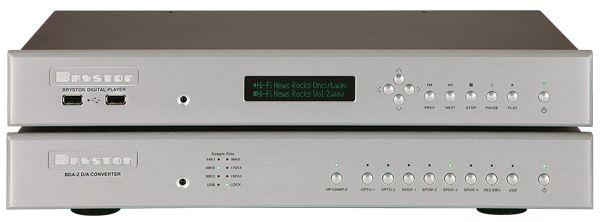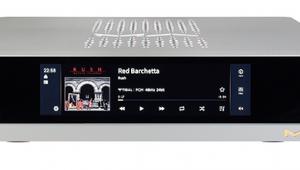Bryston Bdp 2/bda 2 (bdp 2, £3125; Bda 2, £2500)

Canadian audio manufacturer Bryston adopted a purist approach with its first computer audio product, the BDP-1 ‘digital player’ [HFN Apr ’11], this based on an ultra-minimalist computer with four USB sockets for memory sticks or external HDDs.
An enhanced model, the BDP-2 featured here has joined Bryston’s line-up along with a new BDA-2 DAC which includes a 192kHz/24-bit capable asynchronous USB input. This uses proprietary firmware running on the XMOS USB audio micro-controller platform.
Bryston supplies the necessary driver software on a memory stick for Windows PC users (Macintosh supports USB Audio Class 2.0 with most devices). And where the cheaper BDA-1 had 24-bit Crystal CS4398 DACs in a dual-differential configuration, the BDA-2 has 32-bit AKM AK4399 DACs.
As with all its audio components, Bryston places great store in its proprietary discrete Class A analogue output circuitry, eschewing off-the-shelf chip-based op-amps, for both its single-ended and balanced outputs.
There are no fewer than eight digital inputs – six S/PDIF (two Toslink, two RCA, two BNC), a balanced AES/EBU (XLR) and USB. Inputs can be selected directly via front-panel switches or Bryston’s BR2 system remote controller. Input data is synchronously upsampled to either 176.4kHz (for 44.1kHz and 88.2kHz media) or to 192kHz (for 48kHz and 96kHz media).
Bryston’s digital player is designed solely for replaying audio from file storage media connected to its USB sockets. It employs a linear power supply and a modified sound card with S/PDIF (BNC) and AES/EBU (XLR) digital outputs for connecting to any DAC of choice.
Bryston doesn’t claim any sonic enhancements for its new BDP-2 digital player, just significantly improved connectivity and functionality. Under the bonnet is a new Intel Atom-powered motherboard offering three times the processing speed, an eight-fold increase in system memory, and a more robust power supply.
Sharp focus
When playing the Sheffield Lab classic The King James Version the DAC delivered the sound of the lead trumpet without any hint of strain, while faithfully preserving the instrument’s sharp transients and dynamic power.
Similarly Diana Krall’s sultry ‘I’ve Got You Under My Skin’ from When I Look In Your Eyes [Verve] was rendered with a richly saturated palette of tonal colours, the balance creamy and luscious, yet sharply focused, without the slowed-down feeling of ‘laziness’ that an overly-thick tonality can sometimes create.
With both these recordings we preferred them at their native sampling rate rather than upsampled, albeit the effect was subtle. But the effects of upsampling are entirely dependent on the recording itself. For example, tracks from Eric Clapton’s 461 Ocean Boulevard [Polydor] sounded typically compressed and overly processed, yet upsampled, the sizzling guitars appeared less peaky and better defined.
We then set about listening to the BDA-2 using the BDP-2 digital player as a source. Would it blow our computer set-up away? No – but the BDP-2 did sound marginally more precise and transparent. With top-drawer audiophile recordings it delineated instrumental lines with greater ease, and allowed music to flow and breathe with a compellingly engaging naturalness.
Of particular note was the player’s imperturbable dynamic stability. Even during big crescendos the BDP-2 maintained a consistent perspective with instruments anchored in the soundfield. Played via a computer through the BDA-2 DAC, the performance exhibited minor sonic artefacts during peaks, adding glare and projecting the sound slightly forwards.
Verdict
If you owned the BDP-2 and BDA-2 you might find the latter’s USB input superfluous, as hi-res files played by the BDP-2 are likely to be noticeably superior to those from a laptop or computer. And some audiophiles might even welcome its simplicity and limited functionality.
Originally published in the 2014 Yearbook























































